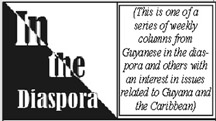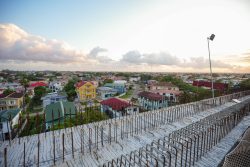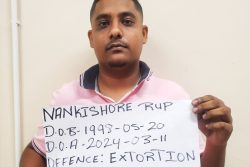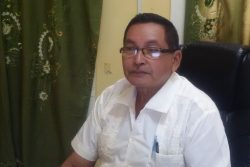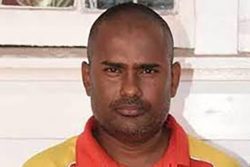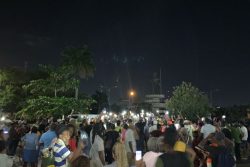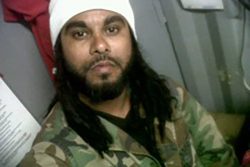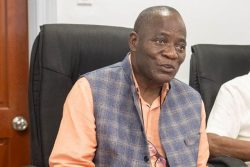Suzanne Narain is a community activist in the Jane-Finch area of Toronto where she grew up, the child of Guyanese immigrants. She is an elementary school teacher and a graduate student at the University of Toronto.
On September 11th, 2014, two Indo-Guyanese women registered to run for city councillor and school board trustee in the municipal elections in Toronto, Canada. 9/11 was chosen as the symbolic date to register as it was the anniversary of the day that life monumentally changed for people of colour, specifically brown folks. Running for the position of city councillor in the previous municipal elections was a significant moment, as I was among several other women of colour candidates. My running mate, Sabrina “Butterfly” Gopaul, and I ran on a slate, her as school board trustee and myself as city councillor. We ran a collaborative grassroots campaign, as we both have been long-time residents and community organizers in the Jane and Finch area of Toronto, an area with a significant Caribbean population. Butterfly works as a community outreach worker, and I am a teacher in the neighbourhood. We decided to run a grassroots campaign together, because in various different capacities, we have been doing frontline work to save our schools from being closed, advocating for food security, and working towards anti-poverty movements more broadly—work that we believe our politicians should be doing. We are also both daughters of Guyanese immigrants to Canada.
I was born in Toronto, Canada, to parents who immigrated from Guyana in the late 1970s. They moved around the city of Toronto, struggled to attain status in Canada, and dealt with the racism that came with being an immigrant at that time. In the mid-eighties my parents settled in the Jane and Finch area, and eventually many of our extended family members joined us in Canada. There were nineteen of us in one home. At the time, there were many Italian immigrants living in the neighbourhood, and while both Guyanese and Italian families were new immigrants in the Canadian nation, there were vast differences in our experiences and appearance. Italian immigrants were white passing, while we clearly were not. When my Guyanese family moved into a predominantly Italian immigrant neighbourhood at the time, we did not fit into the model of a nuclear family and were made to feel out of place in several ways. Often our neighbours would call the police on us for very trivial things like the grass not being cut, cooking curries with smells that infiltrated their homes, the kids running around in their underwear outside or for the music being too loud. The list went on and on. My family never really changed to fit into the neighbourhood, and eventually more Caribbean, Latin American and Asian families moved in who upheld a similar ethic of not adhering to the principles of the dominant culture.
Many of the Italian and white families ended up moving out of the neighbourhood. The first Italian immigrants came to Canada in the 1830s, and there was also a mass migration in the 1870s, which was approximately 100 years earlier than Caribbean immigrants. Italian immigrants, like any other immigrant groups whose second language is English, undoubtedly have a difficult time adjusting to life in Canada and also experience discrimination, yet in terms of political representation, Italian immigrants have made major headway in Toronto and Canada. In almost every aspect of public life growing up in Toronto, white presenting people occupied positions of authority, and my parents and people who looked like them, cleaned their offices. While there is a significant Guyanese population in Toronto, we do not have any political representation in the same ways that Italian, Greek or Sikh immigrants do. Butterfly and I wanted to change this, and tried to mobilize our community.
The campaign that Butterfly and I ran was truly a collaborative, grassroots effort that brought together all the strengths of our community. Both Butterfly and myself have deep roots in the Jane and Finch area, with similar and different experiences of creating ‘home’ and families in the community. Butterfly’s family are also immigrants from Guyana, and as a result of limited childcare options in Toronto, Butterfly spent part of her childhood in Guyana with her grandmother. On her own as a mid-teen, Butterfly navigated the struggles of being a single mom, finding housing and advocating for the best education for her son and youth in the community. Throughout the years, Butterfly has been involved in various projects that connect hip hop with education, anti-poverty movements and food justice to list a few. More than her long list of accomplishments, Butterfly’s home and door is always open to those who need support. She also hosts family dinners for folks who are alone during the holidays, creating a space for chosen family and community.
We entitled our campaign SNS, Suzanne and Sabrina (Butterfly), using the tagline “my family, your family, our community”. The community, and family that we created within it, was the heart and driving force of our campaign. Every aspect of our political platform was created collectively with the community. In under a month, we held several meetings to unpack the issues that we thought were the most pressing in the election: the school-to-prison pipeline; large class sizes; gentrification; poor transportation services; the food desert in Jane and Finch; and the failing state of public housing. We called on the community for support and they showed up with their skills and resources, and delivered in ways that we could not have imagined possible within such a short time frame. We held informal community meetings on the street corner, talking to people about the issues that mattered to them; we canvassed with parents and children, knocking on as many doors as we possibly could. The community mobilized to create a grassroots municipal campaign, with little funding but a lot of heart, energy and commitment to imagining a radically different future. A future that included better transportation, housing and food security, youth excelling in school, parents being welcomed into schools as equals—a better condition of life and livelihood for all.
The campaign that Butterfly and I ran was intentionally designed as a grassroots initiative, to give us the freedom to be honest with our narrative and critiques— we did not have any big funders, just friends, family and people who believed in our platform. We collectively raised enough money to print signs and other promotional materials. In a short period, we were able to shift the conversation, speaking to critical issues, such as the reality of transit in our community, environmental degradation, and the ways in which poverty impacts the social determinants of health. Although, we did not win, the political representatives elected began to mimic the critiques that we expressed, even if they did very little to change policies that actually improved the condition of people’s lives.
Both Butterfly and I decided to run again in the current municipal elections this year, but there were significant changes to the city council size which pushed me out of the elections. Toronto experienced the effects of a power-hungry, conservative provincial government that was elected this past summer, and which changed the boundaries of the municipal wards or district area for the upcoming elections scheduled later this month. The wards decreased from 47 to 25, significantly increasing the citizen to councillor ratio and the amount of power each councillor will have. The reduced council size not only limits the ability for citizens to have their concerns heard, but also makes running for council and political positions even more difficult and out of reach for marginalized citizens across the city. Toronto is comprised of 51% of people of colour, but our elected officials on the city council are primarily all white, middle-aged men, with 11% of the councillors identifying as visible minorities, as per the census data and only a third of whom are women.
Our elected representatives in the city of Toronto do not match the demographic of the city. While these representatives have been democratically elected, it takes a certain amount of class, racial and gender privilege to be able to run and win an election. Changes to the Toronto city council size has shut the door to municipal politics for many young, racialized and/or marginalized people, particularly women who have less access to resources.
With the size of the wards expanding, we can only predict that the needs of the marginalized will be the last thing on the agenda at city hall. One of the current city councillors in the area that I live in, Giorgio Mammoliti, has already threatened to destroy social housing and spray people like cockroaches in Jane and Finch to displace them and break the community solidarities that have been formed. The expanding of the wards and pressing need to get Giorgio Mammoliti out of office is one of the main reasons that I have chosen to withdraw my candidacy in this election. We do need better representation; however, with the expanded wards, there are far more people running in one ward which causes voter fragmentation. The expansion of the wards has inadvertently created a two-tiered system of municipal elections in our neighbourhood between those who have resources and those who do not. The incumbents have teams of people, resources, political clout and expertise in running elections that newer candidates do not have. This is not to undermine the ability, determination and power that new candidates possess, rather, it is to point out the structural barriers that exist that prevent marginalized and racialized people from being on the same playing field, attaining political representation and winning elections in Toronto.
Running a campaign also takes a great deal of emotional energy, and that is not as easy to measure as financial resources. There is a spirit of resiliency in racialized and marginalized communities that allows us to keep thriving and pushing forward, regardless of exclusionary policies. But what are the health implications of continuously fighting for our rights, for equal opportunities, and for our voices to be heard?
Our physical and mental well-being is always compromised but never recognized as being what is at stake for racialized women in political campaigns and broader activist work. Candidates like myself will literally have more area to cover, which will also mean more time and energy required for canvassing — more time that I do not have as a part-time PhD student, part-time elementary school teacher, and full-time community organizer, as well as meeting the demands of daily life. I do not have the privilege to take time off of work to dedicate the additional hours that will be necessary to reach all the residents in the expanded ward. However, Butterfly, is continuing her campaign for school board trustee in the area, because as mother, she cannot afford to stop, especially with her son in public school.

